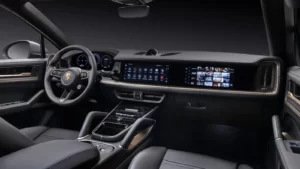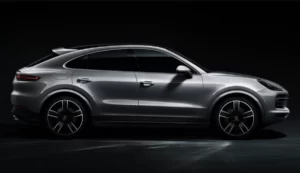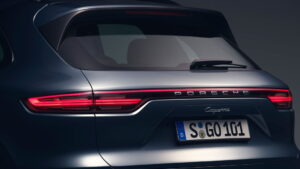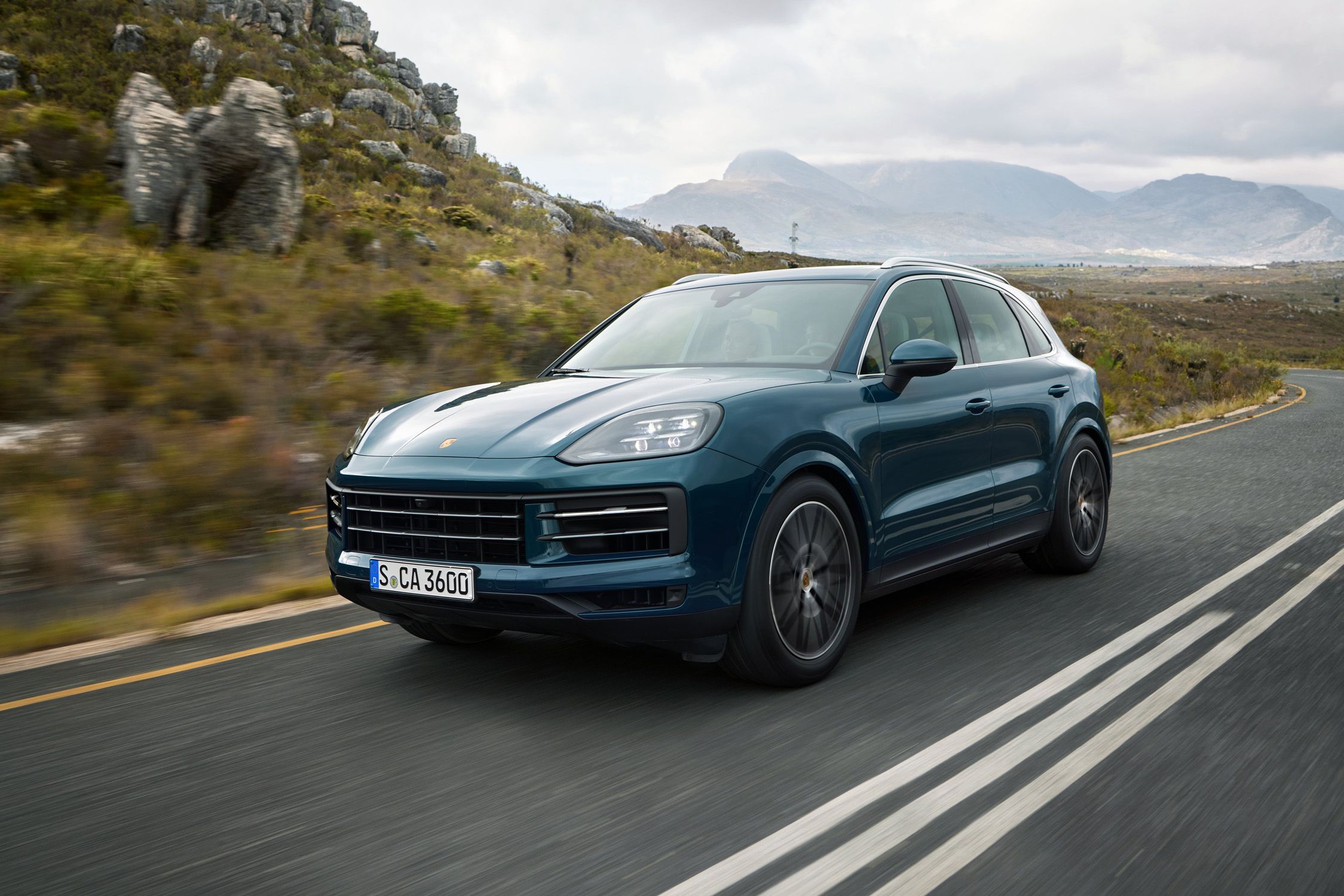A larger, three-row SUV is eventually going top Porsche’s lineup, but until then the Cayenne is top dog.
While it’s not the most affordable Porsche—let alone SUV—in the luxury performance SUV market, the Cayenne has had the distinction of being one of the best you can buy. Unless you needed cargo room, that is, thanks to its coupe-like design. It’s always been engaging and balanced on the pavement, but also far more capable than it might appear to be off-road. It was, however, due for a refresh from the third generation’s 2019 launch and, instead of taking a light pencil to the design, Porsche decided it was time to give the Cayenne a makeover before Stuttgart’s eventual three-row SUV takes over as top dog.
While that bigger SUV will allow more cargo and people inside, the driving dynamics of the Cayenne aren’t on its radar. That’s where we’ll start this look at the 2024 refresh as it’s part of the “most extensive product upgrades in the history of Porsche,” according to its Vice-President for the Cayenne Product Line, Michael Schätzle.

For all models under the Turbo GT—the Cayenne, S, and E-Hybrid trims—the standard suspension will consist of a traditional steel spring combined with Porsche Active Suspension Management (PASM). We were able to experience this when Porsche invited us on a development drive of the 2024 Cayenne. “It’s all very deliberately and highly controlled, like a dancer—the manner in which the weight settles on the outside wheels and the suspension crouches, takes a set, and eventually releases as you exit the turn,” we noted. “Each Cayenne does it the same way, so much so that the driver of a base model can easily keep up with the driver of a Turbo GT who isn’t using enough throttle.”
Optionally and standard on the Turbo GT is a two-chamber adaptive air suspension system. This, combined with the two-valve dampers, will give the new Cayenne even more precision and differentiation between its Normal, Sport, and Sport Plus driving modes. Again, we were able to experience how the Turbo GT offered a tightened-up version of the lesser performance models. There will also be an optional Lightweight Sport Package that will remove up to 72 pounds from the Cayenne, making it even more planted and sure-footed.
Other standard equipment for the 2024 Cayenne Turbo GT include the Porsche Dynamic Chassis Control (PDCC), Porsche Ceramic Composite Brakes, rear-axle steering, and 22-inch GT design wheels with high-performance tires. When we drove the prototype, it wore a set of Pirelli Corsa tires while lower models were on a set of Nexen N Fera Sport SUV tires.
With this being more than just a mere mid-cycle refresh, the exterior of the Cayenne looks familiar and yet different at the same time. The 2024 model comes with a newly designed front end that has more aggressive-looking fenders, a new hood design, and redesigned headlights that really match the stance of the Cayenne. Out back, we see a new set of “three-dimensional” tail lights and a new fascia, which unclutters the rear end while also integrating the license plate holder. This is possibly one of the cleanest rear designs of the Cayenne in its model history.
There will also be three new colours to choose from: Algarve Blue Metallic, Montego Blue Metallic, and Arctic Grey. There are also new wheels for 2024 ranging from 20 to 22 inches to help make your Cayenne yours. All trims of the Cayenne will come in either Coupe or SUV bodies except for the Turbo GT, which is only offered in a Coupe body style along with the exclusive GT Design wheels mentioned earlier.
Of course, any modern luxury SUV is going to come with technology that makes use of the latest ADAS advancements. The Cayenne is no exception and comes standard with Active Speed Limit Assist with Traffic Sign Recognition, Adaptive Cruise Control with a new Evasion Assist to help with emergency obstacle avoidance between 31 and 93 mph, and Turn Assist that monitors oncoming traffic at up to 6 mph. Optionally, there is Porsche’s InnoDrive that has been improved and adds Active Lane Keep and Intersection Assist.
The cockpit of the 2024 Cayenne has also seen some dramatic improvements with a revised display and control scheme. It also now comes with the Porsche Driving Experience. Frequent controls that the driver uses are located on the steering wheel while the left stalk includes new functions related to the ADAS. The gear selector is now on the dashboard, which allows the center console to increase in size for more storage space and allows for a much larger air conditioning controller with a back panel design. The manually adjustable air vent controls are larger while the haptic volume knob are both parts of the experience that tries to strike the right balance of digital and analog elements.


New for 2024, and a first for Porsche, is a curved 12.6 inch instrument cluster that has a freestanding design. The driver will also be able to get instrumentation and information via an optimized HUD as an optional part. The infotainment screen is a standard 12.3-inch Porsche Communication Management (PCM) display that adds native apps like Spotify and Apple Music. Another first for Porsche is an available 10.9-inch display located in front of the passenger and allows them to experience performance data and mapping like a high-performance co-driver or become the controller of entertainment while on a road trip. To ensure the driver isn’t distracted by this screen, a special layer ensures they can’t view it in order to keep their eyes on the road ahead.
While it makes more power across the board when compared to 2023, the Cayenne will also get the twin-turbo 4.0 liter V-8 in the S trim. Not only does this mark the return of the turbocharged eight-cylinder for any trim besides the Turbo GT, it also improves the horsepower and torque output of the S by 34 hp and 37 lb-ft over the turbocharged 3.0 liter V-6—or 468 hp and 442 lb-ft of torque without any electrification boost. The base model Cayenne will still get the turbo six, but it will make 348 hp and 368 lb-ft (that’s a 13-hp, 36-lb-ft improvement over the 2023 version of the 3.0-liter turbocharged V-6).
If you want some electrification, you won’t be left out of the power gain game. While the V-6 is the same as the base model, the new electric motor is now outputting 174 hp to bring its combined output to 463 hp (an 8-hp bump over 2023). It also gets a new battery pack that increases its range by going from a 17.9-kWh capacity to 25.9 kWh. However, the efficiency of the electric motor has also been improved, according to Porsche, but Stuttgart doesn’t mention the mileage increase both the pack and motor advancements create. The only hard number for the pack is the speed at which it charges on AC power. With a new 11-kW charger, the Cayenne E-Hybrid is able to fully charge from depleted in 2.5 hours.
Finally, the Turbo GT’s engine remains the top-of-the-line Porsche 4.0-liter twin-turbo V-8, but it makes far more power than the S and 19 hp more than the 2023 model. At 650 hp, Porsche says the 2024 Cayenne Turbo GT will accelerate from zero to 60 mph in just 3.1 seconds. It will also top out with a speed of 189 mph, aka stinking fast for an SUV.
Starts At Nearly $81,000
You’ll be able to order your 2024 Porsche Cayenne right now, and deliveries to Porsche dealers are expected to start in the summer of 2023. The base model of the Cayenne SUV starts at $80,850 while the Coupe starts at $85,950. The Cayenne E-Hybrid SUV starts at $93,350 while the E-Hybrid Coupe starts at $97,350. The Cayenne S with its new twin-turbo 4.0 liter V-8 starts at $97,350 for the SUV and $103,750 for the Coupe body style. Finally, the Coupe-only Turbo GT will start at $197,950.


source: motortrend




